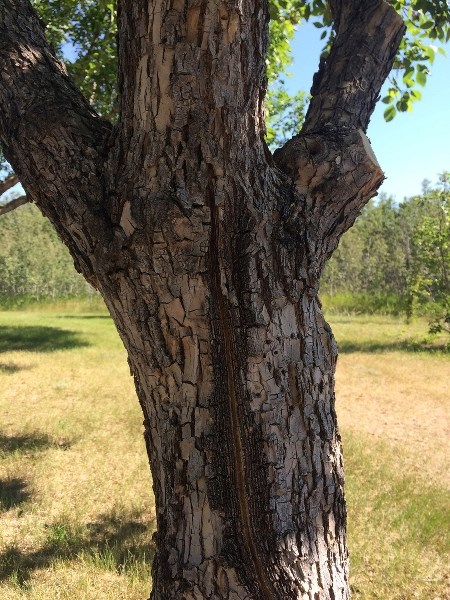Have you ever noticed and wondered about the cause of long vertical cracks in the trunks of some trees? Particularly green ash trees?
A very high percentage of green ash trees on the Prairies have these cracks. Are they something to be concerned with?
These cracks do not seem to harm the tree directly when they occur, however, in the long term, they can cause structural problems or provide an opportunity for the invasion or decay, something to keep an eye on.
These cracks, sometimes called frost cracks, are caused by our Prairie winters when there are sudden changes in temperature.
A live tree is 50 to 60 per cent water, with the remaining part being largely carbon (wood). What happens when you drop an ice cube into your favourite summer beverage? A pop and crack.
I would guess that trees that have a higher moisture content in winter are more likely to have frost cracking.
It is also thought that the ash trees that crack usually crack at a point where the tree was previously injured. The wound wood that develops when a tree is injured is not as flexible as the uninjured parts of the tree and does not expand and contract as easily.
These cracks usually occur on the south and west sides of the tree and usually occur when the nighttime temperatures drop in winter. The cracks tend to close in the summer and appear to heal, only to open up again in the frozen days of a Prairie winter.
If this opening and closing occurs several winters in a row, the tree will develop response growth or wound wood -- sometimes known as ribs -- on either side of the crack. These ribs actually improve the cracked tree's structure and are a sign of a healthy tree trying to repair itself.
To help reduce the occurrence of cracks in your ash, some sources say to avoid late-season fertilizing. Other good housekeeping practices include not damaging the bark of trees when they are young by bumping into them with gardening equipment or tools.
It can really help to put mulch around the tree so that maintenance equipment doesn't have to get as close to the trunk. Lastly, water your trees when the growing season is droughty, like now.
Parting comments: planted trees do not die from drought. They are killed from the lack of adequate provision of supplemental water. If you don't have time to provide the care they need after planting, then maybe plant something that requires no care, like the glow-in the-dark coconut palms.
-- Anderson is executive director of the International Society of Arboriculture-Prairie Chapter and a former Olds College grounds manager. He was also the scorekeeper during the Prairie Tree Climbing Championships, held at Olds College June 18 and 19.
"A live tree is 50 to 60 per cent water, with the remaining part being largely carbon (wood). What happens when you drop an ice cube into your favourite summer beverage? A pop and crack."KEITH ANDERSON FORMER OLDS COLLEGE GROUNDS MANAGER



